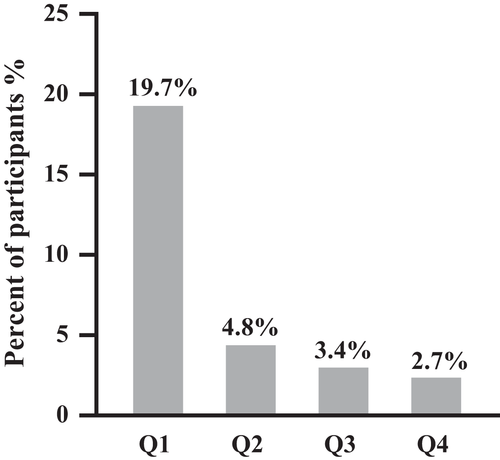Key Points:
- Anemia among middle-aged women is associated with decreased NAD+ levels.
- Health-related blood factors – including red blood cell counts and hemoglobin – are positively associated with NAD+ levels.
When it comes to aging, NAD+ and anemia have a complicated relationship. NAD+ is a molecule essential for numerous cellular processes and is largely considered to be protective, providing anti-aging benefits, including positive effects on cellular metabolism, cellular stress, and the immune system. On the other hand, anemia – a condition in which the body lacks enough red blood cells to carry oxygen through the body – is harmful, with adverse effects on the heart and overall health. With age, NAD+ levels tend to decrease while the prevalence of anemia increases.
In a new study published in the Journal of Cellular and Molecular Medicine, Yang and colleagues from Jinan University in China help to disentangle the relationship between NAD+ and anemia. The researchers found that women with higher levels of NAD+ were less likely to have anemia, especially microcytic anemia (red blood cells are small and lack color) and normocytic anemia (not enough red blood cells). Additionally, hematological parameters – measurements related to blood health – improved with increasing levels of NAD+. Namely, hemoglobin and red blood cell counts were increased, indicating improved oxygen delivery. These findings suggest that boosting NAD+ could potentially be used to treat anemia.
“Haematological parameters…were positively associated with NAD+ contents. Haematological parameters might serve as a predictor for lack of NAD+ in whole blood among women,” the investigators wrote.
Decreased NAD+ and Increased Anemia Risk
Yang and colleagues divided 727 women (average age of 42.7 years) into four groups according to their NAD+ levels. Those with higher levels of NAD+ had lower rates of anemia than those with lower NAD+ levels. In the group with the lowest NAD+ levels, the proportion of anemia patients was the highest. The researchers also looked at the proportion of microcytic (which includes iron deficiency anemia) and normocytic anemia – the more common types of anemia – and found the overall proportion among all participants to be 4.1% and 3.5%, respectively. Both types of anemia decreased with increasing NAD+ levels, possibly suggesting a place for NAD+ supplementation in treating anemia.

Many women are anemic during their child-bearing years, often due to iron deficiency. Iron is a necessary component of hemoglobin – the oxygen-carrying protein on red blood cells. Without iron, the oxygen transferring capabilities of red blood cells are diminished. Yang and colleagues found that women with higher NAD+ levels had higher levels of hemoglobin, suggesting improvements in oxygen delivery. Additionally, higher NAD+ levels were associated with more red blood cells, also indicating improved oxygen transfer. These findings suggest that NAD+ can override the deficiencies in oxygen utilization associated with anemia.

Can Boosting NAD+ Treat Anemia?
Previous studies in mice have shown that low iron levels – as is the case with iron-deficient anemia, which affects about 50% of women worldwide – can affect NAD+ synthesis, leading to low levels of circulating NAD+ in the bloodstream. Additionally, another study done in chicks showed that supplementing with NAD+ protected the chicks from hematological failure, including clotting issues and other blood disorders. Furthermore, studies done in mice with sickle cell disease, a cause of anemia in which misshapen hemoglobin leads to reduced oxygen and sickle-shaped red blood cells, have shown that treatment with NAD precursors improves anemia and decreases cellular stress, indicating a possible role for NAD+ supplementation in the treatment of anemia.
Nearly 20% of those over the age 85 experience anemia. If left untreated, it can lead to numerous complications, including extreme fatigue, heart failure, severe weakness, and poor immunity, further complicating the aging process. Iron supplementation is commonly used to treat iron-deficiency anemia – although sometimes iron supplementation is not enough. Other treatments for anemia vary from supplemental oxygen to increased fluid intake and blood transfusions.
This study by Yang and colleagues helps to partially bridge our understanding in terms of a possible relationship between anemia and NAD+ levels. However, it only focuses on a select group of women in an urban area in China. Further research in other countries is needed to fully understand the interplay between anemia and NAD+. Additionally, a clinical trial where individuals’ NAD+ levels are raised and their effects on anemia measured would be an important piece of the puzzle in further understanding a place for NAD+ supplementation in anemia treatment. Overall, given the data, it seems as though increasing NAD+ levels can benefit those who are anemic.